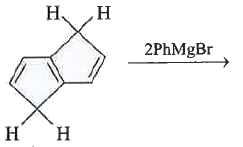Which of the followig ions will finally give a black precipitate with Ag⊕ ion?
SO2−3
Brɵ
CrO2−4
S2O2−3
The correct Answer is:d
To determine which ion will give a black precipitate with Ag^+ (silver ion), we need to analyze the possible reactions of the given ions with silver ions.
1. Identify the Possible Ions:
We need to consider the ions that are typically tested in such questions. Common ions that can react with silver ions include sulfate (SO4^2-), bromide (Br^-), dichromate (Cr2O7^2-), and thiosulfate (S2O3^2-).
2. Reactions with Silver Ion:
- Sulfate (SO4^2-): When sulfate reacts with silver ions, it forms silver sulfate (Ag2SO4), which is a white precipitate and does not turn black.
- Bromide (Br^-): Silver bromide (AgBr) is formed when silver ions react with bromide ions. AgBr is a yellowish-white precipitate and does not turn black.
- Dichromate (Cr2O7^2-): Silver dichromate (Ag2Cr2O7) is formed, which is an orange-red precipitate and does not turn black.
- Thiosulfate (S2O3^2-): When thiosulfate reacts with silver ions, it forms silver thiosulfate (Ag2S2O3), which can further decompose in the presence of water to produce silver sulfide (Ag2S), which is a black precipitate.
3. Conclusion:
Among the ions listed, thiosulfate (S2O3^2-) is the only ion that will ultimately lead to the formation of a black precipitate when reacted with silver ions. The reaction can be summarized as follows:
- Ag^+ + S2O3^2- → Ag2S2O3 (white precipitate)
- Ag2S2O3 + H2O → H2SO4 + Ag2S (black precipitate)
Thus, the correct answer is thiosulfate (S2O3^2-).
Final Answer:
The ion that will finally give a black precipitate with Ag^+ ion is thiosulfate (S2O3^2-).
We need to consider the ions that are typically tested in such questions. Common ions that can react with silver ions include sulfate (SO4^2-), bromide (Br^-), dichromate (Cr2O7^2-), and thiosulfate (S2O3^2-).
- Sulfate (SO4^2-): When sulfate reacts with silver ions, it forms silver sulfate (Ag2SO4), which is a white precipitate and does not turn black.
- Bromide (Br^-): Silver bromide (AgBr) is formed when silver ions react with bromide ions. AgBr is a yellowish-white precipitate and does not turn black.
- Dichromate (Cr2O7^2-): Silver dichromate (Ag2Cr2O7) is formed, which is an orange-red precipitate and does not turn black.
- Thiosulfate (S2O3^2-): When thiosulfate reacts with silver ions, it forms silver thiosulfate (Ag2S2O3), which can further decompose in the presence of water to produce silver sulfide (Ag2S), which is a black precipitate.
Among the ions listed, thiosulfate (S2O3^2-) is the only ion that will ultimately lead to the formation of a black precipitate when reacted with silver ions. The reaction can be summarized as follows:
- Ag^+ + S2O3^2- → Ag2S2O3 (white precipitate)
- Ag2S2O3 + H2O → H2SO4 + Ag2S (black precipitate)
The ion that will finally give a black precipitate with Ag^+ ion is thiosulfate (S2O3^2-).
Topper's Solved these Questions
- D AND F BLOCK ELEMENTSBOOK - CENGAGE CHEMISTRY ENGLISHCHAPTER - D AND F BLOCK ELEMENTSEXERCISE - Exercises Assertion Reasoning
20 Videos
- D AND F BLOCK ELEMENTSBOOK - CENGAGE CHEMISTRY ENGLISHCHAPTER - D AND F BLOCK ELEMENTSEXERCISE - Exercises Integer
10 Videos
- D AND F BLOCK ELEMENTSBOOK - CENGAGE CHEMISTRY ENGLISHCHAPTER - D AND F BLOCK ELEMENTSEXERCISE - Exercises Single Correct Compounds Of Transition Elements (Zinc)
3 Videos
- COORDINATION COMPOUNDSBOOK - CENGAGE CHEMISTRY ENGLISHCHAPTER - COORDINATION COMPOUNDSEXERCISE - Archives Subjective
18 Videos
- ELECTROCHEMISTRYBOOK - CENGAGE CHEMISTRY ENGLISHCHAPTER - ELECTROCHEMISTRYEXERCISE - Archieves Subjective
35 Videos
Similar Questions
Knowledge Check
Which of the following reactions give aromatic ion ?
A B
B C
C D
D
Which of the following ions gives coloured solution?
View SolutionCu2+ ions give white precipitate with :
View SolutionWhich of the followig reaction is not a ion-exchange reaction?
View SolutionWhich of the following ions is not isoelectronic with O2−
View SolutionWhich of the following ions is not isoelectronic with O2−
View SolutionWhich of the following ion is not isoelectronic with O2− ?
View SolutionAmmonia/ammonium ion gives yellow precipitate with:
View Solution
